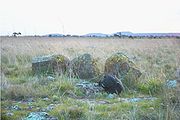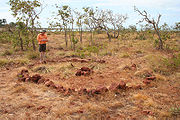
Aboriginal stone arrangement
Encyclopedia

Indigenous Australians
Indigenous Australians are the original inhabitants of the Australian continent and nearby islands. The Aboriginal Indigenous Australians migrated from the Indian continent around 75,000 to 100,000 years ago....
, and are a form of rock art
Rock art
Rock art is a term used in archaeology for any human-made markings made on natural stone. They can be divided into:*Petroglyphs - carvings into stone surfaces*Pictographs - rock and cave paintings...
. Typically, they consist of stones, each of which may be about 30 cm in size, laid out in a pattern extending over several metres or tens of metres. They were made by many different Australian Aboriginal culture
Australian Aboriginal culture
Aboriginal Australia comprises hundreds of tribal divisions and language groups, with a diverse range of cultural practices.-Practices and ceremonies:*A Bora is an initiation ceremony in which young boys become men....
s,and in many case are thought to be associated with rituals.
Particularly fine examples are in Victoria
Victoria (Australia)
Victoria is the second most populous state in Australia. Geographically the smallest mainland state, Victoria is bordered by New South Wales, South Australia, and Tasmania on Boundary Islet to the north, west and south respectively....
, where the stones can be very large (up to 1 metre high). For example, the stone arrangement at Wurdi Youang
Wurdi Youang
Wurdi Youang is an Aboriginal stone arrangement located at Mount Rothwell, near Little River, Victoria at .The arrangement takes the form of an irregular egg-shape or ovoid about 50m in diametre with its major axis East-West...
consists of about 100 stones arranged in an egg-shaped oval about 50m across. Each stone is well-embedded into the soil, and many have "trigger-stones' to support them. The appearance of the site is very similar to that of the megalithic stone circles found throughout Britain
Great Britain
Great Britain or Britain is an island situated to the northwest of Continental Europe. It is the ninth largest island in the world, and the largest European island, as well as the largest of the British Isles...
(although the function and culture are presumably completely different). Although its association with Indigenous Australians
Indigenous Australians
Indigenous Australians are the original inhabitants of the Australian continent and nearby islands. The Aboriginal Indigenous Australians migrated from the Indian continent around 75,000 to 100,000 years ago....
is well-authenticated and beyond doubt, the purpose is unclear, although it may have a connection with initiation rites. It has also been suggested that the site may have been used for astronomical
Australian Aboriginal astronomy
Australian Aboriginal astronomy is a name given to indigenous Australian culture relating to astronomical subjects — such as the Sun and Moon, the stars, planets, and the Milky Way, and their motions on the sky...
purposes (Morieson 2003). Other well-known examples in Victoria include the stone arrangements at Carisbrook and Lake Bolac.
Australia's largest collection of standing stones is said to be at Murujuga
Murujuga
Murujuga , is a peninsula often known as Burrup Peninsula in the Pilbara region of Western Australia, adjoining the Dampier Archipelago and near the town of Dampier...
, also known as the Burrup peninsula or the Dampier archipelago, in Western Australia
Western Australia
Western Australia is a state of Australia, occupying the entire western third of the Australian continent. It is bounded by the Indian Ocean to the north and west, the Great Australian Bight and Indian Ocean to the south, the Northern Territory to the north-east and South Australia to the south-east...
, which includes tall standing stones similar to the European menhir
Menhir
A menhir is a large upright standing stone. Menhirs may be found singly as monoliths, or as part of a group of similar stones. Their size can vary considerably; but their shape is generally uneven and squared, often tapering towards the top...
s, as well as circular stone arrangements.

Arnhem Land
The Arnhem Land Region is one of the five regions of the Northern Territory of Australia. It is located in the north-eastern corner of the territory and is around 500 km from the territory capital Darwin. The region has an area of 97,000 km² which also covers the area of Kakadu National...
, where there are detailed images of the praus used by Macassan fisherman fishing for Trepang
Trepang
Trepang may refer to:*trepang, a marine invertebrate harvested by trepanging, thus:**a common name for species of the holothuroidea class of animals*Trepang , a World War II submarine sunk in 1967....
, several hundred years before European contact. Here the stones are small (typically 10–20 cm), sit on the surface of the ground, and can easily be moved by hand, which also implies that they can be easily damaged or altered by modern hands, so that caution is needed when interpreting such sites. Similar examples are found scattered throughout Australia, mainly in remote or inaccessible places, and it is likely that there were many more prior to European settlement of Australia.
In South East Australia are found Bora rings
Bora (Australian)
A Bora is the name given both to an initiation ceremony of Indigenous Australians, and to the site on which the initiation is performed. At such a site, young boys are transformed into men. The initiation ceremony differs from culture to culture, but often involves circumcision and scarification,...
which consist of two circles of stones, one larger than the other, which were used in an initiation ceremony and rite of passage
Rite of passage
A rite of passage is a ritual event that marks a person's progress from one status to another. It is a universal phenomenon which can show anthropologists what social hierarchies, values and beliefs are important in specific cultures....
in which boys were transformed into men.
Further reading
- Lane, L., & Fullagar, R., 1980,”Previously unrecorded aboriginal stone arrangements in Victoria”, Records of the Victorian Archaeological Survey, No. 10, June 1980, 134-151. Ministry for Conservation, Victoria.
- MacKnight & Gray “Aboriginal Stone Pictures - Art In Eastern Arnhem Land”, 1969
- Morieson, J., 2003,”Solar-based Lithic Design in Victoria, Australia”, in World Archaeological Congress,Washington DC, 2003
- Morieson, J., 2006, “Ceremonial Hill”, published leaflet
- Mountford, 1927, “Aboriginal Stone Structures in South Australia” , Trans & proc. Roy. Soc. South Australia

